|
More and more often, headlines boast of new cancer genes found.
No wonder people are left with many unanswered questions. What is the connection between such gene discoveries and cancer? Is there a connection between genes and cancer's diagnosis or treatment?
The answers to these and other gene questions lie in understanding gene discovery, the science behind gene testing--the ability of researchers to identify changes within genes that may predict the future development of specific diseases, help diagnose existing diseases, or, someday, make it possible to treat or even ward off disease.

The story of gene testing begins with DNA.
DNA is a vast chemical information database. It resides in the core, or nucleus, of each of the body's trillions of cells, and it carries the complete set of instructions for making all the proteins a cell will ever need.
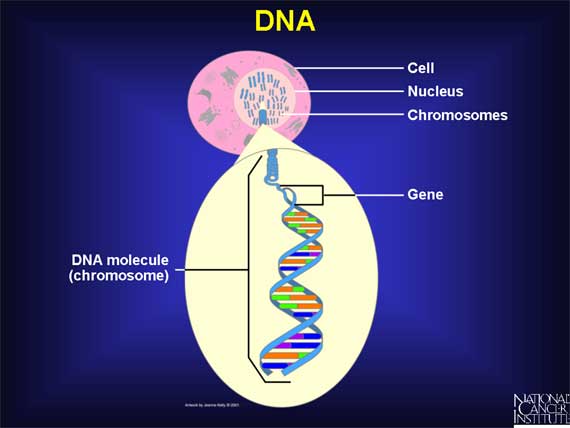
DNA exists as two long, paired strands spiraled into the famous double helix.
Each strand is made up of millions of chemical building blocks called bases. There are only four different chemical bases in DNA (adenine, thymine, cytosine, and guanine), but they can be arranged and rearranged in countless ways. The order in which the bases occur determines the messages to be conveyed, much as specific letters of the alphabet combine to form words and sentences.
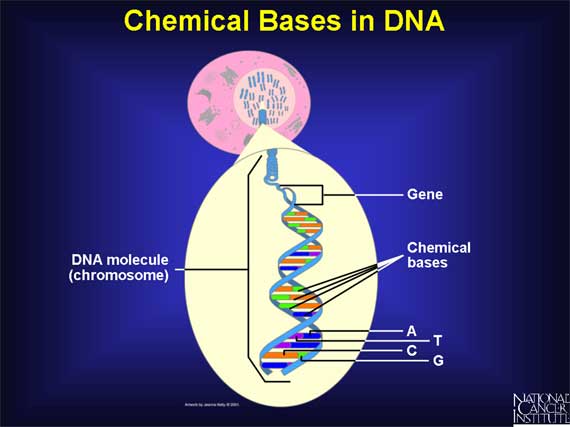
Every human cell (with the exception of mature red blood cells, which have no nuclei) contains the same DNA.
Each cell has 46 molecules of double-stranded DNA. Each DNA molecule is made up of 50 to 250 million bases housed in a chromosome.
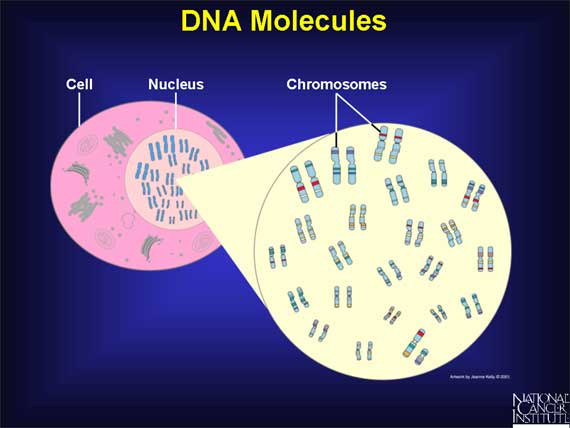
A gene is a working subunit of a DNA molecule.
A gene is any given segment along the DNA carrying a particular set of instructions that allows a cell to produce a specific product--typically, a protein such as an enzyme. There are about 25,000 genes, and every gene is made up of thousands, even hundreds of thousands, of chemical bases.
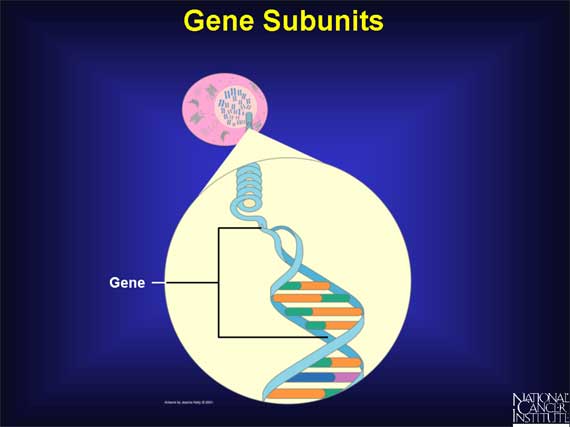
Building proteins lies at the heart of cell function.
For a cell to make a protein, the information from a gene is copied, base by base, from a strand of DNA into a strand of messenger RNA. Messenger RNA travels out of the nucleus into the cytoplasm, to cell organelles called ribosomes. There, messenger RNA directs the assembly of amino acids that fold into a completed protein molecule.
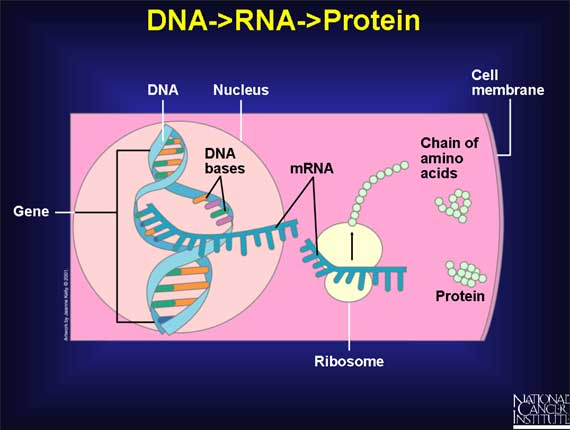
Although each cell contains the genetic potential to make all possible human proteins, cells use genes selectively.
Some housekeeping genes encode proteins needed for basic cell functions, and these genes stay active all the time in many cell types. More typically, though, a cell activates just the genes it needs at the moment and actively suppresses the rest. The unique selection of genes used by a cell gives that cell its character--making a brain cell, say, different from a bone cell.
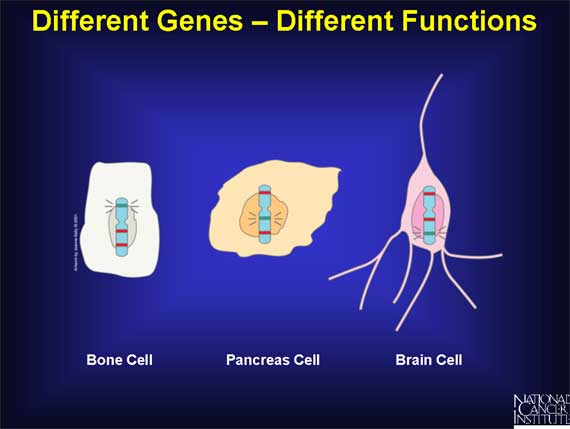
A sound body depends on the continuous interplay of thousands of proteins, acting together in just the right amounts and in just the right places--and each properly functioning protein is the product of an intact gene.
Many, if not most, diseases have their roots in our genes. More than 4,000 diseases stem from altered genes inherited from one's mother and/or father. Common disorders such as heart disease and most cancers arise from a complex interplay among multiple genes and between genes and factors in the environment.
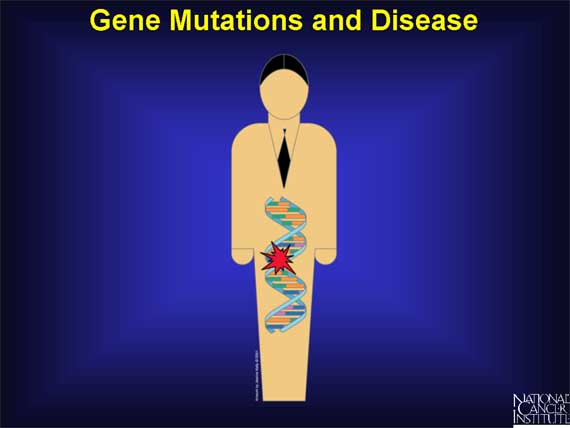
Genes can be altered, or mutated, in many ways.
The most common gene change involves a single base mismatch--a misspelling--placing the wrong base in the DNA. At other times, a single base may be dropped or added. And sometimes large pieces of DNA are mistakenly repeated or deleted.
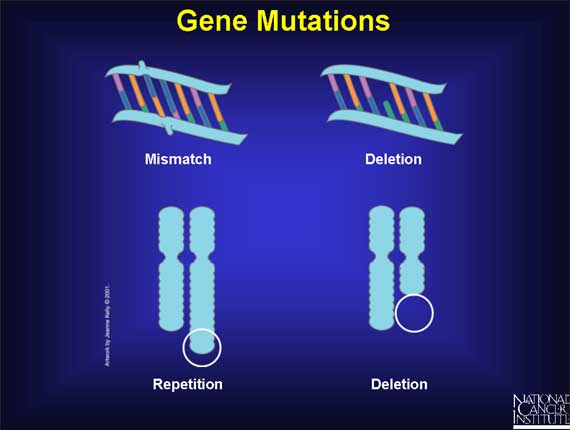
When a gene contains a mutation, the protein encoded by that gene is likely to be abnormal.
Sometimes the protein will be able to function, but imperfectly. In other cases, it will be totally disabled. The outcome depends not only on how it alters a protein's function but also on how vital that particular protein is to survival.
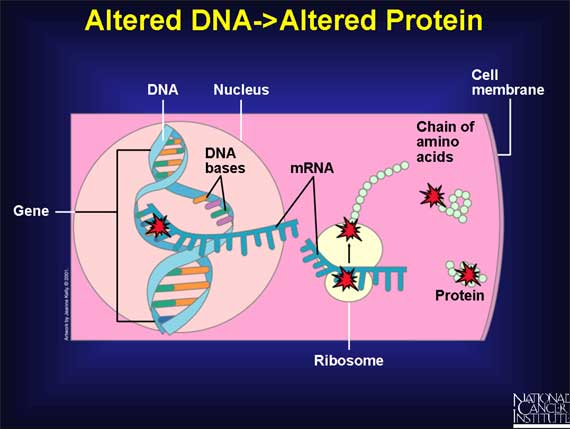
Gene mutations can be either inherited from a parent or acquired.
Hereditary mutations are carried in the DNA of the reproductive cells. When reproductive cells containing mutations combine to produce offspring, the mutation will be in all of the offspring's body cells. The fact that every cell contains the gene change makes it possible to use cheek cells or a blood sample for gene testing.
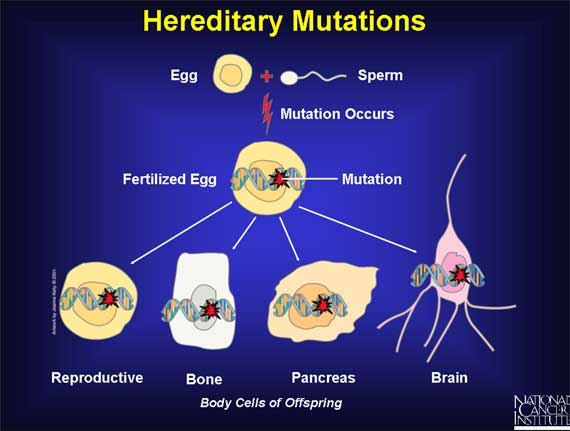
Acquired mutations are changes in DNA that develop throughout a person's lifetime.
Although mistakes occur in DNA all the time, especially during cell division, a cell has the remarkable ability to fix them. But if DNA repair mechanisms fail, mutations can be passed along to future copies of the altered cell.
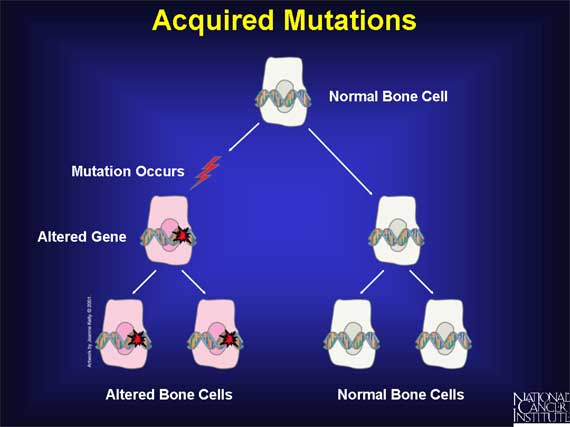
Human cells contain two sets of chromosomes, one inherited from the mother and one from the father.
Each set has 23 single chromosomes--22 autosomes and a sex-determining chromosome, either X or Y. The set shown here is from a male, since it contains an X and a Y chromosome; if the chromosome set were from a female, it would contain an X and an X.
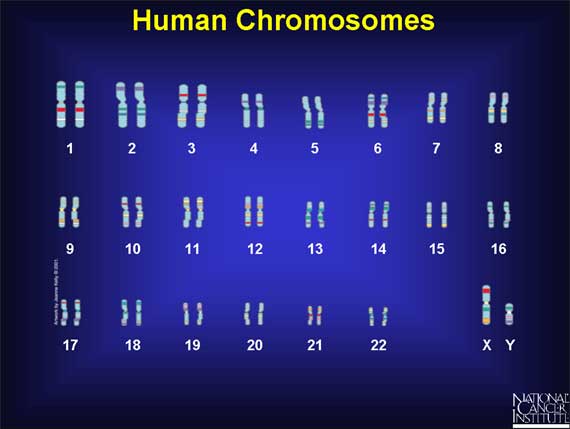
Genes come in pairs, with one copy inherited from each parent.
Many genes come in a number of variant forms, known as alleles. A dominant allele prevails over a normal allele. A recessive allele prevails if its counterpart allele on the other chromosome becomes inactivated or lost.
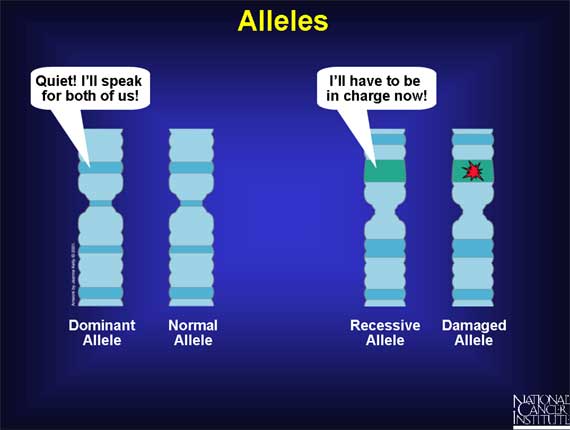
In dominant genetic disorders, one affected parent has a disease-causing allele that dominates its normal counterpart.
Each child in the family has a 50 percent chance of inheriting the disease allele and the disorder.
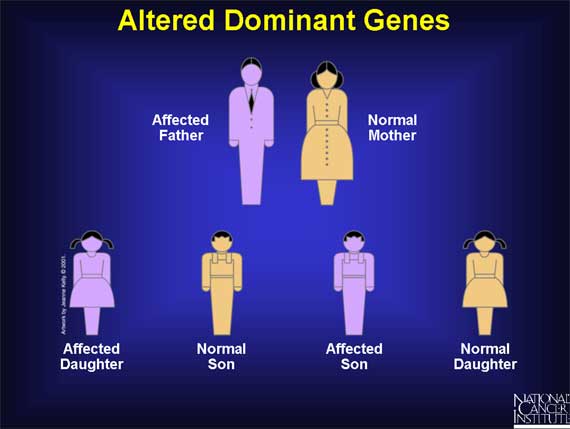
In diseases associated with altered recessive genes, both parents--though disease free themselves--carry one normal allele and one altered allele.
Each child has one chance in four of inheriting two altered alleles and developing the disorder; one chance in four of inheriting two normal alleles; and two chances in four of inheriting one normal and one altered allele and being a carrier like both parents.
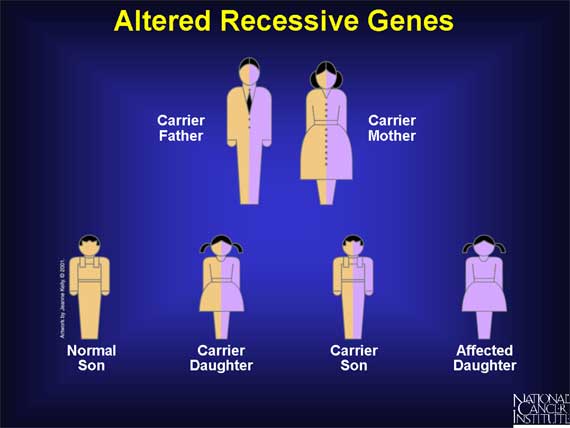
Most diseases do not follow simple patterns of inheritance.
Many factors influence a gene's ability to build proteins. For one thing, different mutations in the same gene can produce a wide range of effects. In cystic fibrosis, for example, the gene that controls mucus production can have more than 300 different mutations; some cause severe symptoms; some, mild symptoms; and some, no symptoms at all.
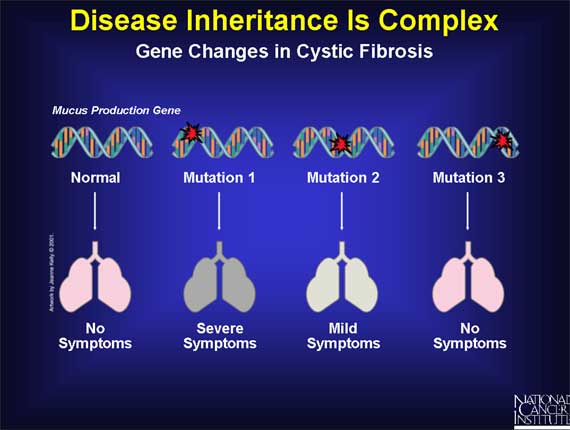
Gene testing involves examining a person's DNA--typically taken from cells in a sample of blood--for mutations linked to a disease or disorder.
Some genetic tests can identify changes in whole chromosomes. Others examine short stretches of DNA within genes. Yet others look for the protein products of genes.
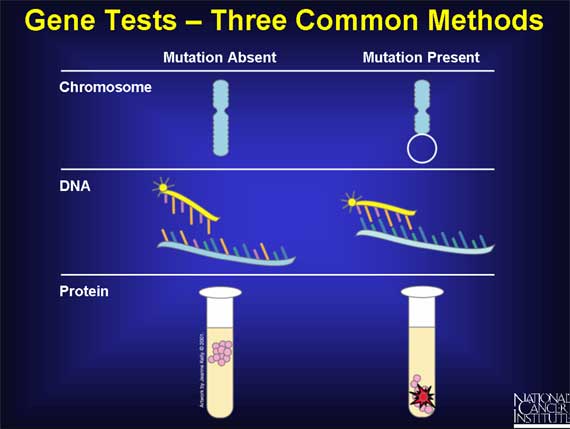
Genetic tests serve many purposes. They are widely used to screen newborns for a variety of disorders. Often this information enables the doctors to minimize the damage caused by the mutation.
In oncology, doctors use gene testing to diagnose cancer, to classify cancer into subtypes, or to predict a patient's responsiveness to new treatments.
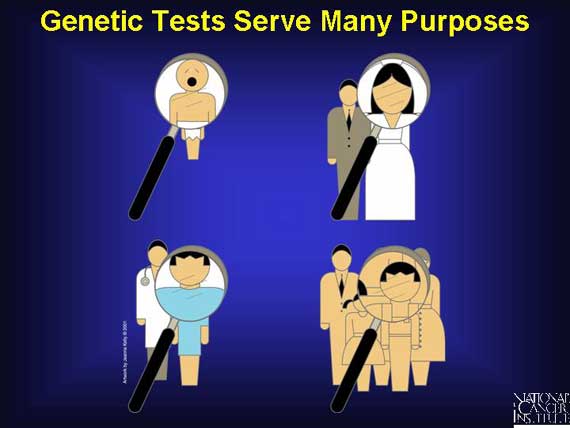
Much of the excitement today centers on gene expression profiling that uses a technology called microarrays. A DNA microarray is a thin-sized chip that has been spotted at fixed locations with thousands of single-stranded DNA fragments corresponding to various genes of interest. A single microarray may contain 10,000 or more spots, each containing pieces of DNA from a different gene. Fluorescent-labeled probe DNA fragments are added to ask if there are any places on the microarray where the probe strands can match and bind. Complete patterns of gene activity can be captured with this technology.
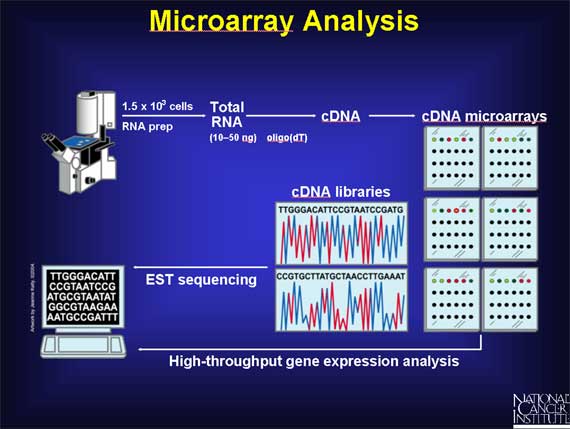
Identifying genes associated with disease--indeed, tracking down every chemical base in each of the estimated 25,000 genes as well as the spaces between them, a process called mapping the human genome--has been accomplished successfully by an international collaboration known as the Human Genome Project.
Scientists have developed a consensus sequence, laying out the order in which all the human genes sit along the chromosomes. This information can be used to determine where gene mutations occur in specific diseases. For example, here is a chart of disease-linked genes located along the X chromosome.
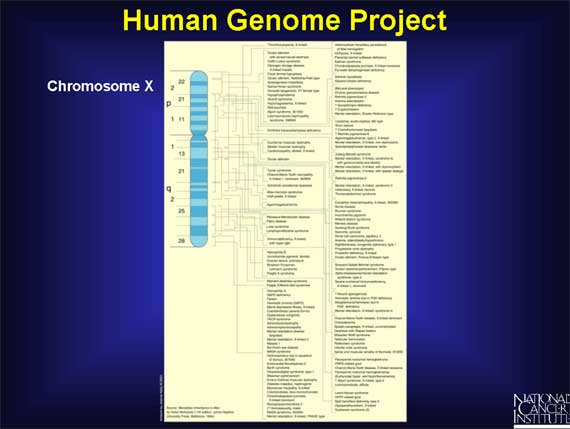
To study specific genes, scientists can now use information from the Human Genome Project to locate a gene's position along a chromosome.
Scientists clone or copy specific sites to obtain millions of identical copies, which are then stored. Researchers then retrieve the appropriate clone and use it for additional experiments.

Scientists searching for disease-linked genes often begin by studying DNA samples from "disease families" in which numerous relatives, over several generations, have developed the illness.
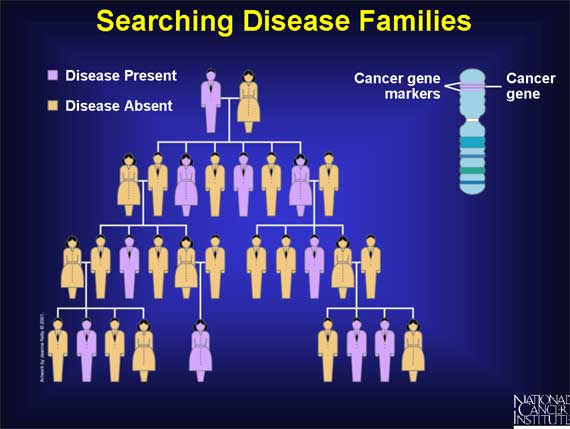
The scientists look for altered regions of the human genome--known DNA segments
containing disease-linked mutations-- that are consistently inherited by
persons with the disease and are not found in relatives who are disease free.
Researchers use this information and tools from the Human Genome Project to
zero in on the exact location of the altered gene or genes and characterize the
specific base changes.
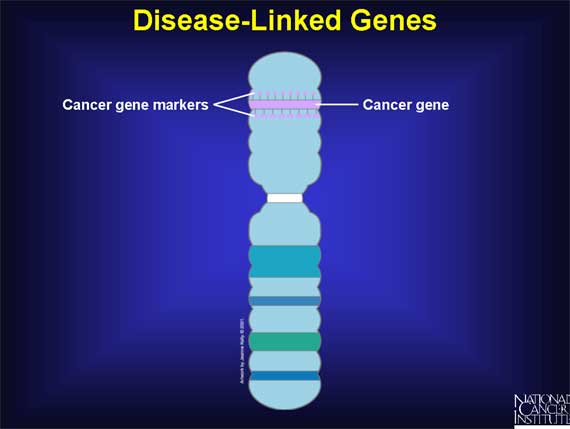
Gene tests are already available for some two dozen disorders, including life-threatening diseases such as cystic fibrosis and Tay Sachs disease.
Gene tests for some cancers are also available. Specific genetic mutations have been identified as linked to several types of cancer, and, for some cancer types, this information has been converted into clinical tests. For example, scientists identified gene mutations that are linked to an inherited tendency to develop colon or breast cancer, and tests for an inherited susceptibility to these cancers are commercially available.
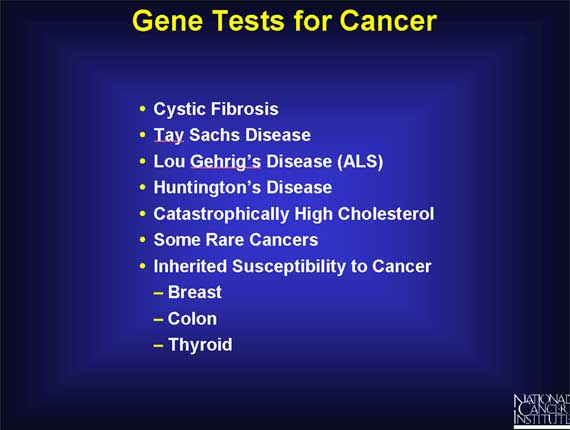
All cancer is genetic, in that it is triggered by altered genes. Genes that control the orderly replication of cells become damaged, allowing the cells to reproduce without restraint.
Cancer usually arises in a single cell. The cell's progress from normal to malignant to metastatic appears to involve a series of distinct changes in the tumor and its immediate environment, and each is influenced by different sets of genes.
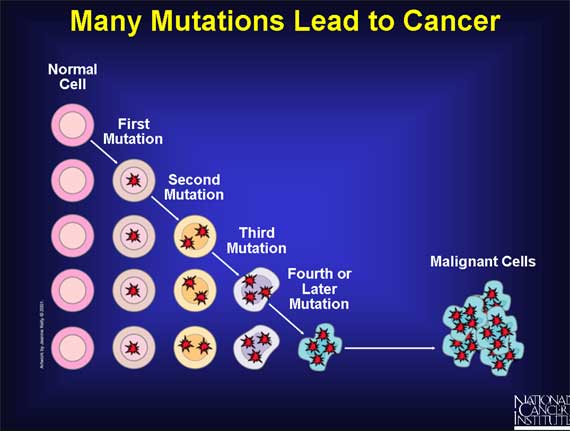
Even though all cancer is genetic, just a small portion--perhaps 5 or 10 percent--is inherited.
Most cancers come from random mutations that develop in body cells during one's lifetime--either as a mistake when cells are going through cell division or in response to injuries from environmental agents such as radiation or chemicals.
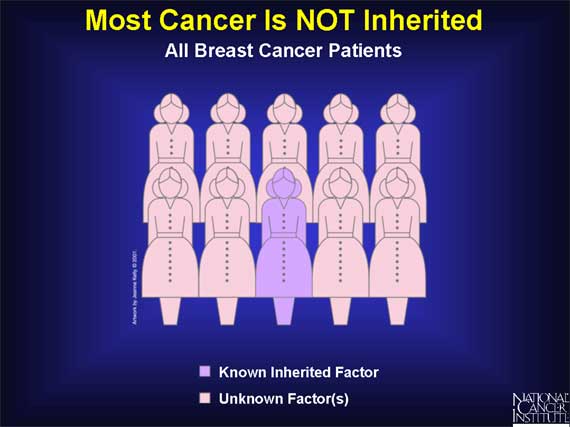
An accurate gene test can tell if a mutation is present, but that finding does not guarantee that disease will develop.
For example, women with the BRCA1 breast cancer susceptibility gene have an 80 percent chance of developing breast cancer by the age of 65. The risk is high but not absolute. And family members who test negative for the BRCA1 mutation are not exempt from breast cancer risk; over time, they can acquire breast cancer-associated genetic changes at the same rate as the general population.
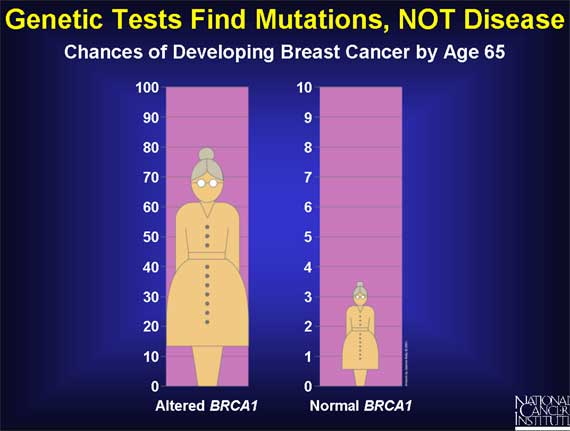
Gene testing offers several benefits.
A negative result can create a tremendous sense of relief and may eliminate the need for frequent checkups and tests that are routine in families with a high risk of cancer. Even a positive result can relieve uncertainty and allow a person to make informed decisions about the future. A positive result can also let a person take steps to reduce risk before disease has a chance to develop.
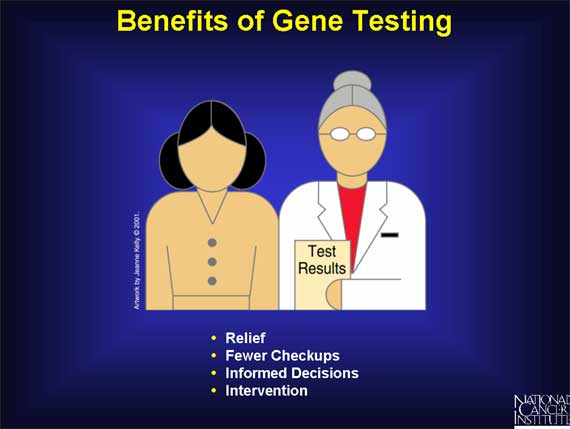
Gene testing has several limitations.
For example, some disorders that "run in families" can be traced to shared environmental exposures rather than any inherited susceptibility. In addition, some mutations detected by a positive test may never lead to disease. Furthermore, because existing tests look only for the more common mutations in a gene, some disease-causing mutations may escape detection.
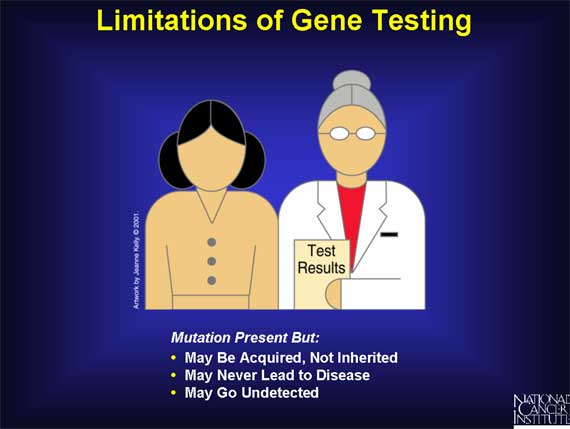
Perhaps the most serious limitation of gene testing is that test information is not matched by state-of-the-art diagnostics and therapies.
To receive positive test results when there is no adequate treatment can be tragic.
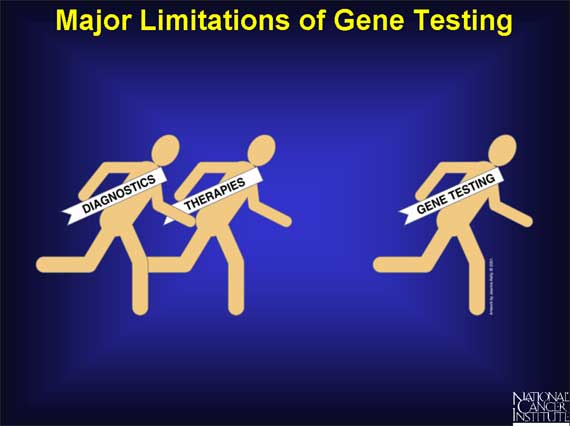
Although gene testing poses little physical risk--usually no more than giving a blood sample--it can seriously affect a person's life.
A test confirming the risk of a serious disease can trigger profound psychological consequences.
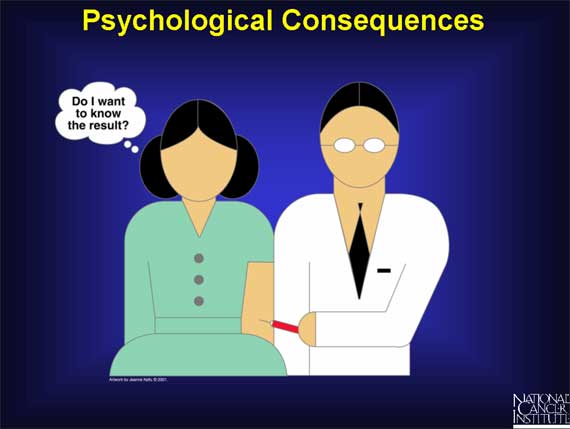
Because gene tests reveal information not only about the individual, but about his/her relatives and future offspring, the results can challenge family and other personal relationships.
With whom should a person share test results? Do the other family members want to know?
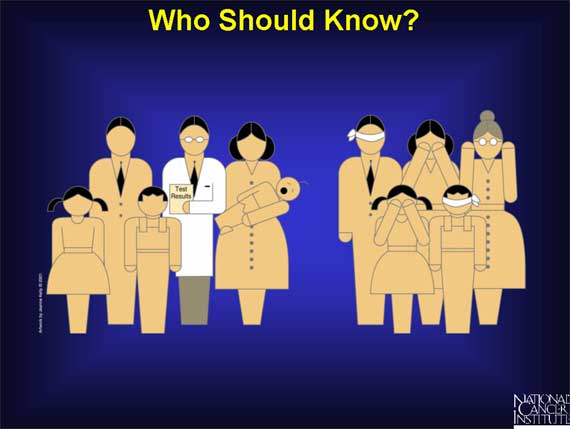
Because gene test results hold a wealth of information, confidentiality is a major concern.
In 2005, the Federal government passed a law to protect a person's confidentiality concerning the results of gene tests. The law prohibits insurance companies and employers from discriminating against anyone based on knowledge of confidential genetic information about that person.
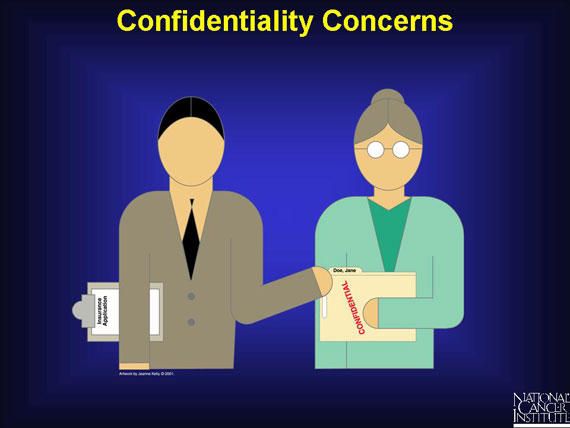
Deciding to have a gene test is difficult.
In 1994, a poll asked people if they would take a test to predict diseases that might occur later in their lives; they were not told whether or not treatment or preventive measures would be available. About the same number of people said "no" as said "yes."
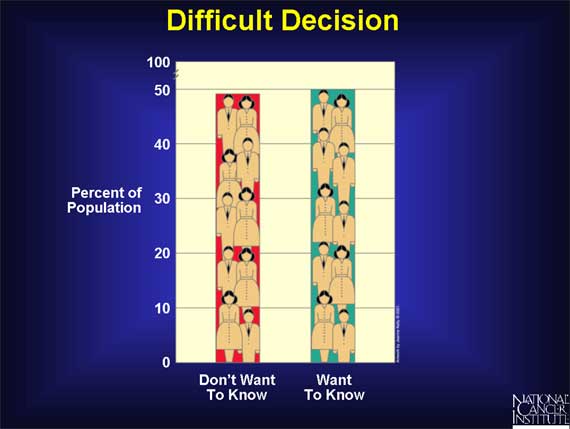
The decision to undergo testing is a very personal one, and experts stress that it should be totally voluntary.
After receiving genetic counseling, a person should agree to the test only if she or he wants the information, not to accommodate relatives, health care providers, or anyone else. An important consideration to weigh is this: If the results are positive, are there available methods for state-of-the-art early detection? prevention? treatment?
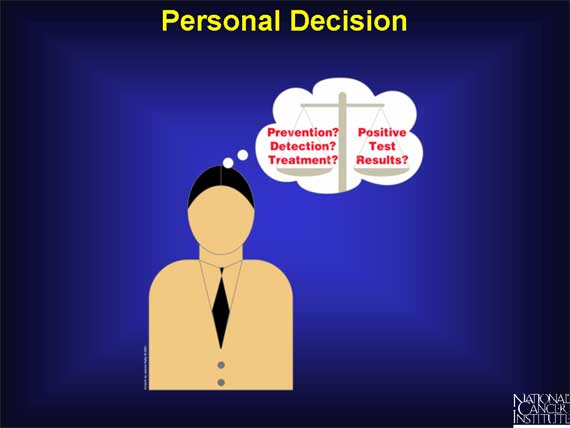
Genetic counselors have a vital role to play.
These specially trained health professionals are skilled at supporting individuals when testing is being considered, when test results are received, and during the weeks and months afterward.
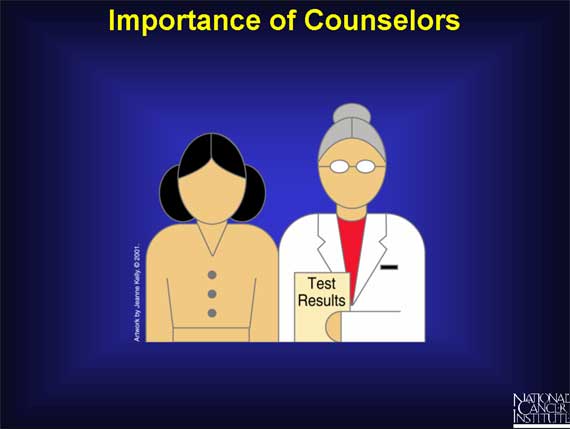
Since gene tests are designed to identify persons who have inherited a gene mutation, the first candidates for study will be members of high-risk families.
Later, tests may be offered to persons whose family history is less telling. Some day it may be possible to test a single blood sample for a whole range of gene mutations.
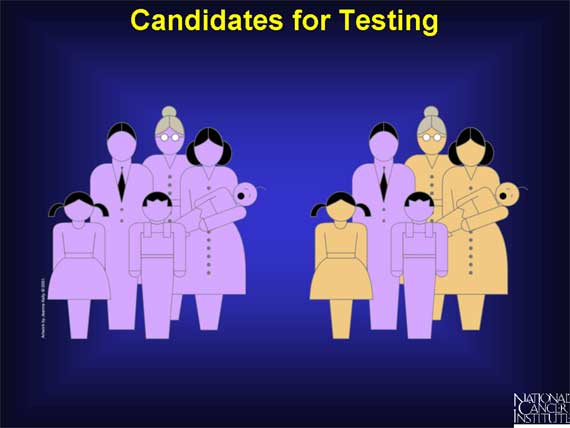
Before gene tests become generally available, specialists and society at large must come to grips with major technical, ethical, and economic concerns.
If widespread gene testing becomes a reality, it will be necessary to develop tests that are simple, cost-effective, and accurate. Testing thousands to millions of people will require many new labs and personnel as well as more genetic counselors. And widespread gene testing will require that many health care providers have a basic understanding of genetic principles in order to interpret the tests.
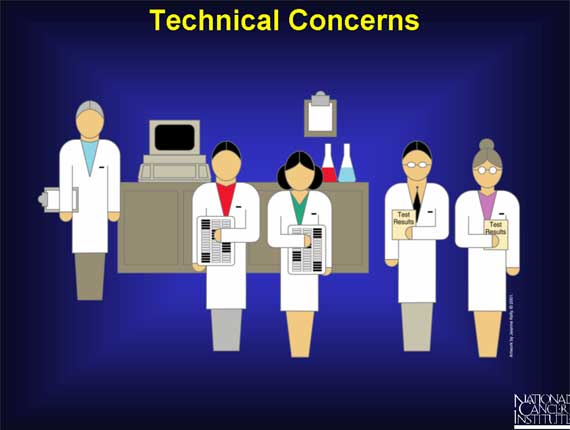
|